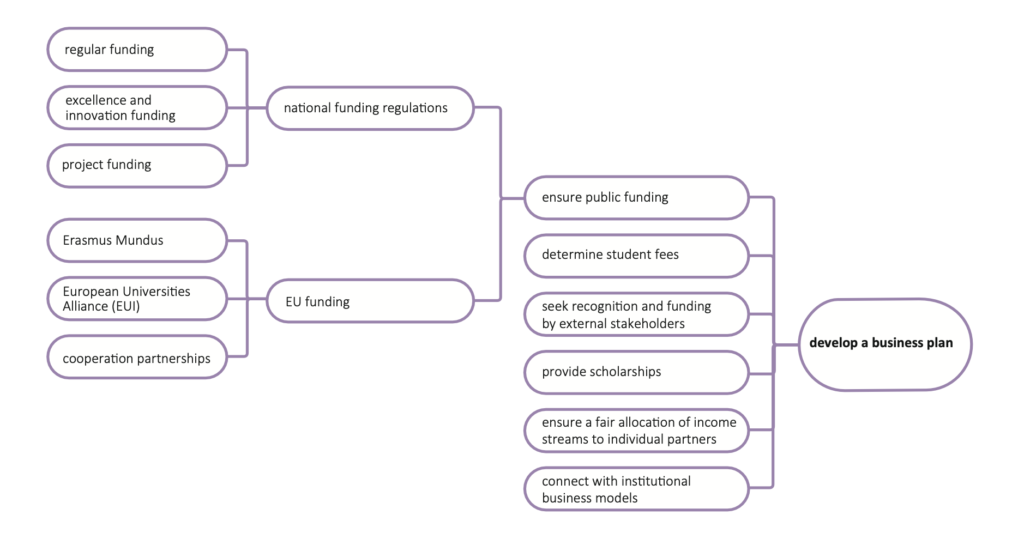
| The partnership has to develop a business plan for the joint master’s programme which is dependent from a set of parameters and national and institutional policies and strategies: |
| • Ensure public funding; |
| • Determine student fees; |
| • Seek recognition and funding by external stakeholders; |
| • Provide scholarships. |
| • Ensure a fair allocation of income streams to individual partners; |
| • Connect with institutional business models. |
Guidelines
Ensure public funding
The national funding of joint master’s programmes can vary widely from country to country. Master’s programmes are funded from primary funding from universities. Since a master’s programme is composed of several courses from different universities, the overall government funding of a joint master’s can be challenging.
When the funding is based on the number of students, European students count in the same way as national students, while the regime for non-EU students can be quite different.
National project funding is supportive for the development of new joint master’s programmes, but not sufficient to ensure their long-term sustainability.
European funding for the preparation, the development and implementation of joint master’s programmes can be found in the Erasmus Mundus scheme as well as by integration of joint programmes in Cooperation Partnerships (European Commission, Erasmus + Programme Guide, 2021)
Most importantly, the development of joint master’s programmes is also funded “indirectly” under the European Universities Initiative (EUI), with which alliances develop innovative education and mobility formats.
Provide student fees
The partners jointly set a registration fee for the joint master’s programme. Possibly, they can differentiate this fee for individual and collective registrations. They must ensure that individual fees are affordable for learners.
A complicating factor is that tuition fees for higher education generally differ from country to country and in some countries even tuition fees are not paid.
In determining enrollment costs, partners need to balance fees in different national systems and other public and private revenue streams on the one hand, and the operational costs of the programme on the other.
Seek recognition and funding by external stakeholders
In some areas relevant to employability and innovation, partners may seek the interest of external stakeholders such as companies, business sectors or professional organizations to recognize and support a joint master’s programme, for example through sectoral funds.
In some countries, personal learning accounts are created and can support students participating in joint master’s programmes eligible for continuing education.
Provide scholarships
In the case of high enrollment costs, joint learning programmes can provide scholarships to individual students, sponsored by companies or other stakeholders.
Ensure a fair allocation to partners
With government funding, partners are bound by national regulations. When developing business models, fees and private funding flows can be split between partners based on their actual contribution to the programme.
Connect with Institutional business models
Joint master’s programmes form an integral part of an institution’s education offer. At the same time, they are co-owned by each individual partner university. Consequently, they should be managed as a separate entity in each institution. In order to promote innovation, the income streams for joint programmes should be allocated directly to the faculty and to the joint programme team.
next chapter: Develop a student recruitment plan
previous chapter: Agree on a joint quality assurance and accreditation scheme
back to overview: Models and guidelines for the design and development of joint master’s programmes
